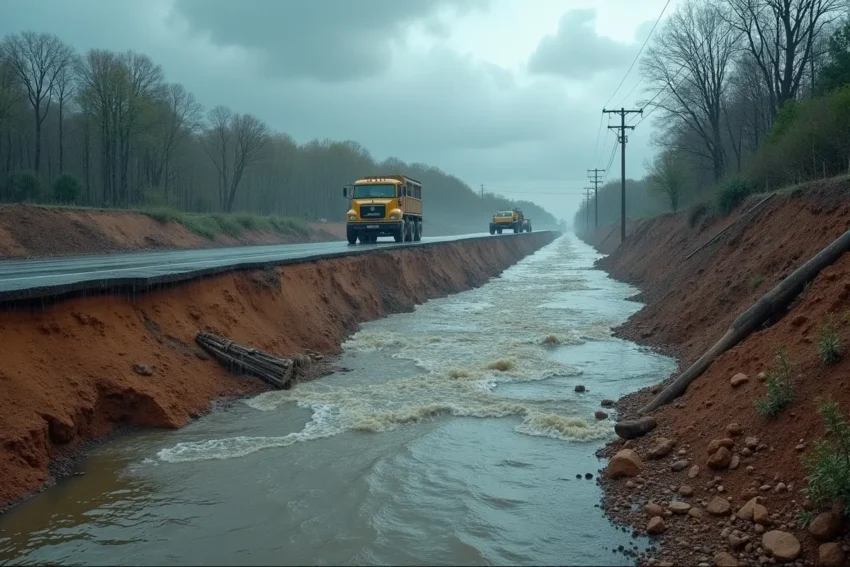Stormwater management is one of the most overlooked yet critical aspects of road safety, especially in areas where construction is underway. Without the right safeguards in place, heavy rainfall can wash away soil, weaken road surfaces, and create conditions that put drivers in immediate danger.
For construction companies, municipalities, and even local communities, erosion control is not simply about protecting project timelines—it is about protecting lives. The Cohen & Jaffe Law Office has frequently emphasized that the consequences of ignoring erosion risks are both practical and legal, as unsafe conditions can lead to accidents and liability claims.
How Stormwater Erosion Threatens Roads
Damage to Road Integrity
When construction sites are left without stabilizing vegetation or protective barriers, rainwater can erode soil at a rapid pace. This runoff removes the very foundation that supports roadways, leaving them vulnerable to cracking, collapse, or total failure.
Drivers who encounter these weakened surfaces may not realize the danger until it is too late. Over time, even moderate erosion can compromise structural integrity, making every trip through these corridors a safety risk.
The Rising Likelihood of Accidents
As erosion eats away at roads, the physical impact becomes clear: potholes deepen, sinkholes appear, and uneven pavement forces drivers into risky maneuvers. A sudden jolt from hitting an unseen pothole may cause a driver to lose control, while uneven road surfaces can cause vehicles to veer into other lanes. On top of this, poor drainage allows standing water to collect, making hydroplaning a constant threat. Even a small pool of water can cause catastrophic consequences at highway speeds.
When Erosion Sparks Mudslides
In the most severe cases, unchecked erosion can unleash mudslides or debris flows. These fast-moving events can cover entire roadways in mud, rocks, and tree limbs within minutes. Not only do they block access routes, but they can also strike moving vehicles with tremendous force.
For drivers caught in their path, survival depends on reaction time and luck. Rescue operations may be delayed if emergency vehicles are unable to reach the scene, leaving those trapped in hazardous conditions for extended periods.
Safety and Legal Considerations
The dangers posed by erosion extend beyond physical safety to questions of accountability. If a construction company or municipality fails to implement proper erosion control measures, it could be held responsible for any accidents that occur. Victims may pursue claims arguing that negligence in site management created unsafe conditions.
This is where experienced legal guidance becomes essential. Working with professionals, such as the Cohen & Jaffe Law Office, can help injured parties understand their rights and clarify whether liability falls on those responsible for maintaining construction sites. For project managers and local governments, consulting legal experts is also a way to ensure compliance with safety regulations before issues escalate.
Solutions That Work Against Erosion
Addressing erosion requires a blend of innovative techniques and practical safeguards. Among the most effective measures are:
- Sustainable Drainage Systems (SuDS): These systems replicate natural water absorption by using permeable pavements, green roofs, and wetlands. They slow runoff, filter pollutants, and prevent soil from being washed away. SuDS not only protect roads but also improve water quality and support ecosystems.
- Erosion Control Blankets: During the early stages of construction, when vegetation has not yet developed, biodegradable mats made of straw, jute, or coconut fiber can stabilize loose soil. These blankets offer immediate protection and, as they decompose, enrich the soil to encourage long-term plant growth.
- Advanced Hydrological Modeling: Predictive software allows engineers to simulate rainfall events and identify erosion hotspots before damage occurs. With this data, resources can be deployed more efficiently, ensuring that protective measures are placed exactly where they are needed most.
Building Safer Roads for the Future
Erosion caused by stormwater is more than an inconvenience—it is a direct threat to public safety and infrastructure. Construction zones, already challenging to navigate, become far more dangerous when soil is not properly stabilized and drainage systems fail.
By adopting sustainable solutions and taking proactive steps, communities can significantly reduce the risks associated with erosion. Ultimately, managing stormwater responsibly is not just about preventing project delays; it is about ensuring that every driver who passes through a construction corridor can do so safely.

